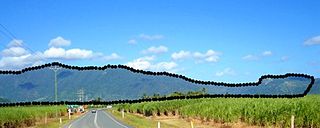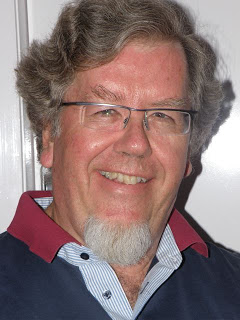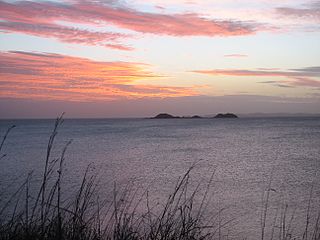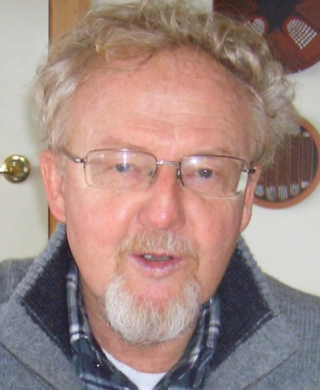Related Research Articles

Australian Aboriginal religion and mythology is the sacred spirituality represented in the stories performed by Aboriginal Australians within each of the language groups across Australia in their ceremonies. Aboriginal spirituality includes the Dreamtime, songlines, and Aboriginal oral literature.

Torres Strait Islanders are the Indigenous Melanesian people of the Torres Strait Islands, which are part of the state of Queensland, Australia. Ethnically distinct from the Aboriginal peoples of the rest of Australia, they are often grouped with them as Indigenous Australians. Today, there are many more Torres Strait Islander people living in mainland Australia than on the Islands.

A corroboree is a generic word for a meeting of Australian Aboriginal peoples. It may be a sacred ceremony, a festive celebration, or of a warlike character. A word coined by the first British settlers in the Sydney area from a word in the local Dharug language, it usually includes dance, music, costume and often body decoration.

The Gubbi Gubbi people, also known as Kabi Kabi, are an Aboriginal Australian people native to south-eastern Queensland. They are now classified as one of several Murri language groups in Queensland.

The Djagaraga or Gudang are an Australian Aboriginal tribe, traditionally lived in the coastal area from Cape York to Fly point, including also Pabaju, in the Cape York Peninsula, Queensland. In the early period of white settlement as the Somerset tribe, after the settlement of Somerset established on their lands in 1863.
Ceremonial dancing has a very important place in the Indigenous cultures of Australia. They vary from place to place, but most ceremonies combine dance, song, rituals and often elaborate body decorations and costumes. The different body paintings indicate the type of ceremony being performed. They play an important role in marriage ceremonies, in the education of Indigenous children, as well as storytelling and oral history. The term corroboree is commonly used to refer to Australian Aboriginal dances, although this term has its origins among the people of the Sydney region. In some places, Aboriginal people perform corroborees for tourists. In the latter part of the 20th century the influence of Indigenous Australian dance traditions has been seen with the development of concert dance, with the Aboriginal Centre for the Performing Arts (ACPA) providing training in contemporary dance.
Bush medicine comprises traditional medicines used by Indigenous Australians, being Aboriginal and Torres Strait Islander people. Indigenous people have been using various components of native Australian flora and some fauna as medicine for thousands of years, and a minority turn to healers in their communities for medications aimed at providing physical and spiritual healing.

Nevill Drury was an English-born Australian editor and publisher, as well as the author of over 40 books on subjects ranging from shamanism and western magical traditions to art, music, and anthropology. His books have been published in 26 countries and in 19 languages.

The Kuku Nyungkal people are a group of Aboriginal Australians who are the original custodians of the coastal mountain slopes, wet tropical forests, waters, and waterfalls of the Upper Annan River, south of Cooktown, Queensland
Umpila, also known as Ompeila, Ompela, Oom-billa, or Koko-umpilo, is an Aboriginal Australian language, or dialect cluster, of the Cape York Peninsula in northern Queensland. It is spoken by about 100 Aboriginal people, many of them elderly.
Guugu Yalandji, also spelt Kuku-Yalanji, is an Australian Aboriginal language of Queensland. It is the traditional language of the Kuku Yalanji people.
The Nicholson River is a river in the Northern Territory and the state of Queensland, Australia.
The Lardil people, who prefer to be known as Kunhanaamendaa, are an Aboriginal Australian people and the traditional custodians of Mornington Island in the Wellesley Islands chain in the Gulf of Carpentaria, Queensland.

Umagico is a town and coastal locality in the Northern Peninsula Area Region, Queensland, Australia. In the 2021 census, the locality of Umagico had a population of 394 people.
The Gunggari, are an Aboriginal Australian tribe of southern Queensland. The traditional land of the Gunggari centres on the Maranoa River and overlaps with the land of the surrounding Mandandanji, Kooma, Kunja, Margany, Dharawala, Bidjara and Nguri peoples. They are to be distinguished from the Kuungkari, who also border Dharawala country.

Wurrwurrwuy stone arrangements is a heritage-listed indigenous site at Yirrkala, Northern Territory, Australia. It is also known as Wurrwurrwuy. It was added to the Northern Territory Heritage Register on 15 August 2007 and to the Australian National Heritage List on 9 August 2013.

Erich Kolig is an Austrian–New Zealand cultural and social anthropologist whose research has focussed on Muslim and Islamic social and religious issues, and Australian Aboriginal culture. He has written and edited 13 books, as well as publishing many scientific papers and book chapters.

A cleverman is a traditional healer and keeper of culture in many Aboriginal cultures of Australia. The roles, terms for, and abilities of a cleverman vary between different Aboriginal nations. Some clevermen heal bodily injuries and illnesses, while others heal spiritual ailments. They heal using plants, songs, and spiritual knowledge. Exceptionally powerful clevermen are believed to have magical powers and may heal both physical and spiritual ailments. Some sources also refer to clevermen having the ability to kill using magic, although this may be illegal within the culture or a separate form of harmful 'sorcery' from that used by cleverman healers. Clevermen also serve as cultural keepers and are experts in stories and spiritual beliefs. They have a strong understanding of sacred places and lore and a deep connection to the Dreaming. Clevermen may be men or women, depending on the culture.
Lynne Hume is an Australian anthropologist of religion whose research interests include Australian Aboriginal spirituality, paganism, consciousness studies and religious dress. She is an Honorary Associate Professor in Studies in Religion at the University of Queensland.

Ysola Mary Best was an Australian author and elder of the Yugambeh people. Best is known for her works and role in preserving the language, history and culture of the Yugambeh. She wrote about aboriginal culture and history. Most of her published works are about the Yugambeh language group of South East Queensland.
References
- ↑ Mudrooroo (1996). "Maban reality and shape-shifting the past: Strategies to sing the past our way". Critical Arts. 10 (2): 1–20. doi:10.1080/02560049685310111.
- A. P. Elkin (1973). Aboriginal Men of High Degree: Initiation and Sorcery in the World's Oldest Tradition. Inner Traditions.
- Munn, Nancy D. (1984). "The Transformation Of Subjects Into Objects in Walbiri and Pitjantjartjara Myths." In: M. Charlesworth, H. Morphy, D. Bell and K. Maddock, Eds. Religion in Aboriginal Australia: An Anthology. St. Lucia, Queensland: University Of Queensland Press.